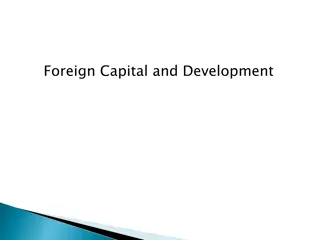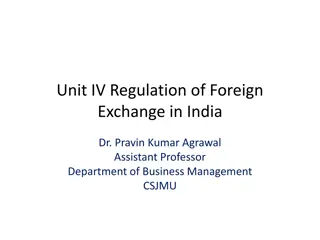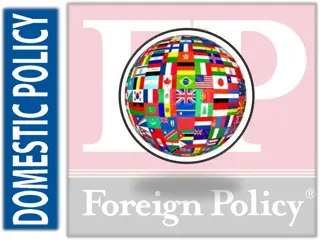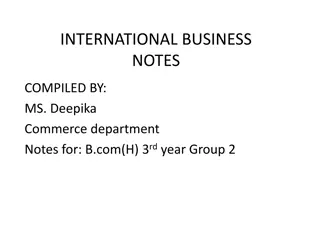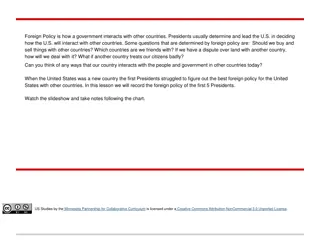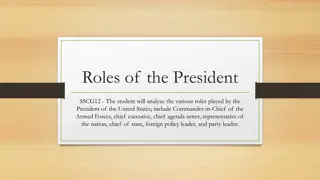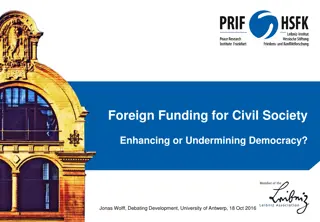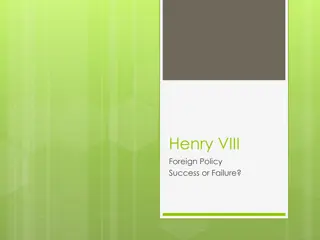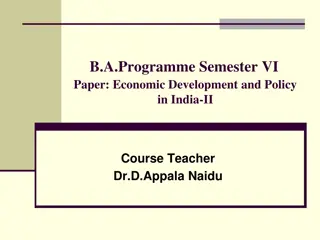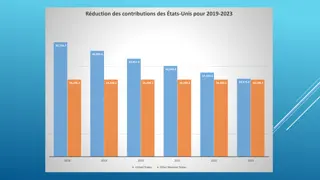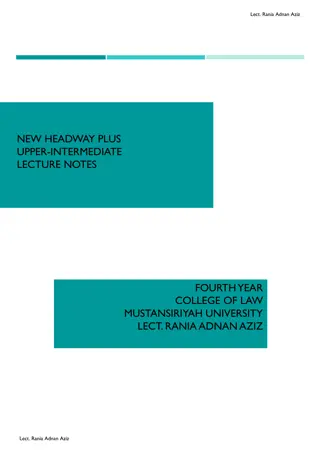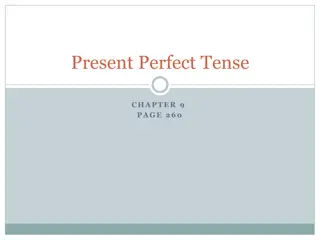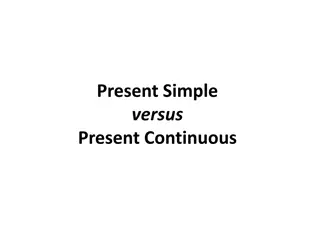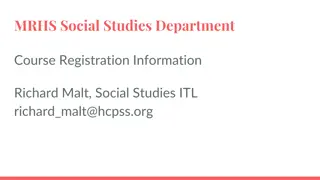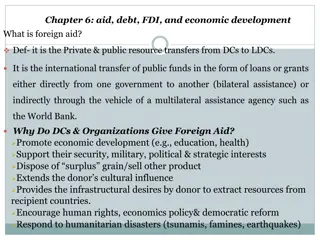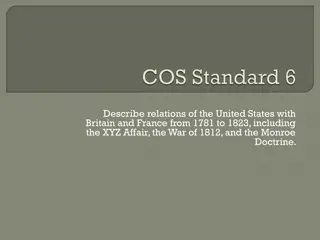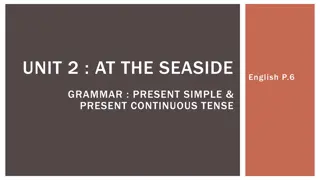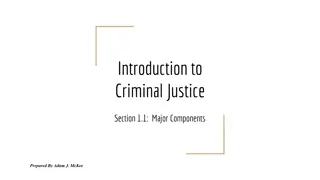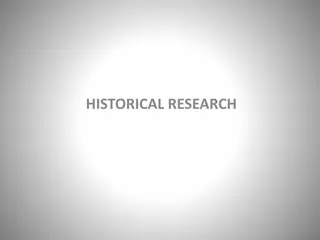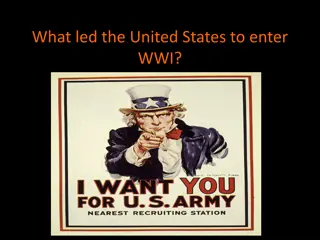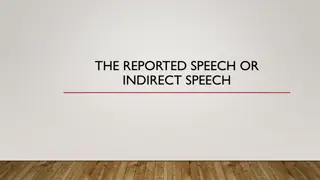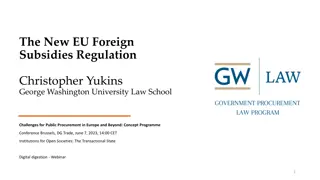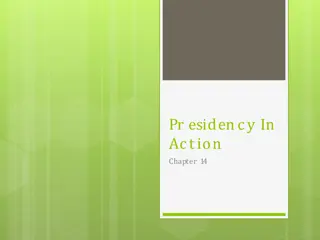United States Foreign Policy: Past, Present, and Future
The post-war period marked the rise of the United States as a key player in international relations, driven by ethical and democratic principles. Today, the US foreign policy focuses on maintaining global dominance, combatting terrorism, upholding economic interests, promoting democracy, and seeking peace and prosperity worldwide. Goals include preserving national security, promoting peace, and cooperating with allies. The policy is shaped by various actors, primarily the President and the State Department.
Uploaded on Sep 25, 2024 | 0 Views
Download Presentation

Please find below an Image/Link to download the presentation.
The content on the website is provided AS IS for your information and personal use only. It may not be sold, licensed, or shared on other websites without obtaining consent from the author. Download presentation by click this link. If you encounter any issues during the download, it is possible that the publisher has removed the file from their server.
E N D
Presentation Transcript
BY- Rakesh Ranjan Dept. of Political Science, PU
The post war period has been described as American era of international relations. The ethical and democratic principles occupied an important position in USA foreign policy , Not only its domestic but even international actions were greatly influenced by values, like/dislike for exploitation & tyranny ,brief Individual liberty and equality dedication to the rule of law among the nations ,peaceful settlement of international disputes. So, USA was promoting such type of behaviour in foreign policy to create and maintain its positive Image in outer world. At the present stage USA has great influence on the globalised world and leading it as super power.
At the current age major & core objectives of USA foreign policy are under: 1. Remain a dominant power of the world. 2. Leading the war on terror with alliance states. 3. To Promote& achieve its hidden economic interests & other benefits through UNO cover. 4. To maintain its image as liberal & developed state. 5. To promote the Justice & democracy among the Nations. 6. Seeking for global peace & prosperity for itself and for rest of world as well.
The US Foreign policy goals include the following: Preserving the national security of the United States Promoting world peace and a secure global environment Maintaining a balance of power among nations Working with allies to solve international problems Promoting democratic values and human rights Furthering cooperative foreign trade and global involvement in international trade organizations Examining these goals closely reveals that they are based on cooperation with other nations, although "preserving the national security of the United States" implies possible competition and conflict.
As with all policy making, many people and organizations have a hand in setting United States foreign policy. The main objective of foreign policy is to use diplomacy or talking, meeting, and making agreements to solve international problems. The President almost always has the primary responsibility for shaping foreign policy. According to the Constitution, Presidents sign treaties with other nations with the "advice and consent" of the Senate. So the Senate, and to a lesser extent, the House of Representatives, also participate in shaping foreign policy.The Secretary of State and many other officials of the State Department play major roles in setting foreign policy.
Unilateralism is an approach in international relations in which states act without regard to the interests of other states or without their support. Unilateralism is usually contrasted with its opposite approach, multilateralism. Multilateralism is acting cooperatively with other states. Though unilateralism is often used in a negative way, experts agree that there are positive aspects to occasionally acting unilaterally, such as in issues of national self- defence.
Unilateralism, by contrast, refers to a tendency to opt out of a multilateral framework (whether existing or proposed) or to act alone in addressinga particular global or regional challenge rather than choosing to participate in collective action. Multilateralism requires states to follow international norms and pay more respect to international institutions; this is contrasted with unilateralism, where a single state can influence how international relations can be conducted.
From Multilateralism to New Unilateralism in US Foreign policy During the Cold War when there was bipolar distribution of power, the United States supported the establishment of multilateral cooperation in the world. Soon after the dissolution of the Soviet Union there was expectation for multipolar distribution of power in Europe. However, as the former Soviet Union lost its power, the United States emerged as the world unipolar power, and there emerged unilateral distribution rather than multipolar distribution of power. The American foreign policy priorities became much clearer after 9/11.
In US foreign policy, since 2001 there was a great change from multilateral engagement to new unilateralism . Unilateralism is not a new approach for US foreign policy. But new unilateralism has some specific characteristics such as change in the policy of deterrence, the emphasis on pre emption, on the US power, will to act alone and advancing democracy. There are critics inside and outside the United States about this strategy.
Policy of deterrence Deterrence posited that weapons are necessary for to assure that no enemy would attack the United States or its allies. After 1990, the US-Soviet bipolar deterrence relationship of the Cold War has been replaced by a group of states, non-state actors, such as terrorists, ethnic militias, cults and organized criminals . Furthermore, neo-conservatives have assumed that threat to the United States and the world can come from rouge states such as Iraq, Iran and North Korea, weak and failed states like Afghanistan and Iraq, because they relate terrorism with the WMD. Thus, the meaning of threat has broadened after the Cold War.
Pre-emptive strike It is apparent that there was a shift in the US policy of containment and deterrence applied during the Cold War with a new policy of pre-emptive attack on enemy state developing WMD. Pre-emption is the use of military force in advance of a first use of force by the enemy. It is an act of anticipatory self-defence in a war initiated by the enemy . After 9/11 terrorist attacks, US security policy is to apply pre-emptive strike in order to prevent acts of terrorism. This policy has been used as a justification for military intervention in Iraq. A link has been made between rouge states, terrorist groups and the WMD. It is warned that terrorists could now attack the United States with the WMD through their rouge allies.
Emphasis on power The United States declared that they enjoy a position of unparalleled military strength and great economic and political influence. It is hard to challenge US unilateralism, because the United States is the only country with military, diplomatic, economic, technological and political power, thus, can act unilaterally. Many scholars believe that the US behaves unilaterally because it can. Yet, US power is not unlimited, but it is unprecedented too powerful to counterbalance, there can be no other major power against the United States. The United States has dominance over the leadership of IMF; globalization spreads American values and favors American interests. Thus, these will further promote American unilateralism
Emphasis on Democracy New unilateralism advocates promoting and advancing democracy and preserving peace by the United States being of last resort. According to the NSS, the United States will actively work to bring the hope of democracy, development, free markets and free trade to every corner of the world. After 9/11 terrorist attack, the US advanced a policy to create democratic political institution in Afghanistan and Iraq and furthermore throughout the Middle East and North Africa. Thus, during the Bush administration democratic transformation became the main pillar of the American foreign policy.
An example of a unilateral action is the American President Donald Trump's decision to withdraw from the Paris Climate Accord is in 2017. The Paris Climate Accord was negotiated and approved by nearly 200 nations around the world, and involved climate change--an issue that is impossible to combat significantly if countries are not united in fighting it. The unilateralism is one of the oldest concepts in the United States foreign policy and has been prac- ticed throughout the American history
The unilateralism is one of the oldest concepts in the United States foreign policy and has been practiced throughout the American history. The unilateral policy involves the independent actions on international arena without taking into account any other ally states. There is a debate between unilateralism and multilateralism in American foreign policy. In the post-9/11 era we have observed a resurgence of Unilateralist preferences in the US foreign policy.


